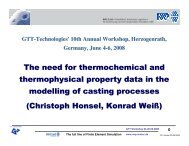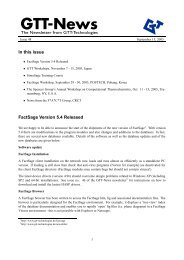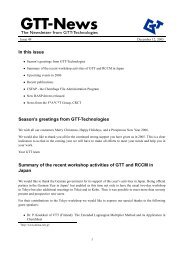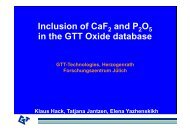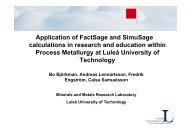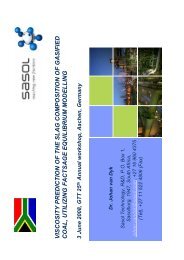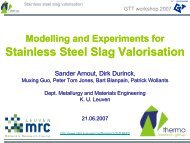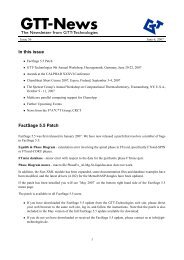full presentation - RWTH Aachen University
full presentation - RWTH Aachen University
full presentation - RWTH Aachen University
You also want an ePaper? Increase the reach of your titles
YUMPU automatically turns print PDFs into web optimized ePapers that Google loves.
Mitglied der Helmholtz-Gemeinschaft<br />
Investigations of Degradation Phenomena in High Temperature<br />
Discharge Lamps using Thermo chemical Modelling<br />
Torsten Markus and Sarah Fischer<br />
Institute for Energy Research (IEF-2)<br />
Forschungszentrum Jülich GmbH<br />
52425 Jülich<br />
T.Markus@fz-juelich.de<br />
T. Markus <strong>RWTH</strong>-<strong>Aachen</strong> Jan 07<br />
1
Content<br />
• Insight into Modern Light Sources<br />
• Corrosion and Chemical Transport<br />
• Calculation Design<br />
• Results<br />
• Conclusion<br />
16. Juni 2010 Institute of Energy Research (IEF-2) 2
PCA-Lamps<br />
Lamp-burner<br />
(PCA)<br />
PCA = Poly Crystalline Alumina<br />
16. Juni 2010 Institute of Energy Research (IEF-2) 3
Aplications for High Intensity Discharge Lamps<br />
16. Juni 2010 Institute of Energy Research (IEF-2) 4
16. Juni 2010 Institute of Energy Research (IEF-2) 5
DyI 3<br />
16. Juni 2010 Institute of Energy Research (IEF-2) 6
Schematic of a High Pressure Discharge Lamp<br />
Wall Material Al 2O 3<br />
Tungsten Electrode<br />
Wall Corrosion<br />
Alumina<br />
Deposition<br />
1380K<br />
1340K 1340K<br />
1300K<br />
5000K<br />
1310K<br />
Metal Halide Melt<br />
e.g. NaI / TlI / DyI 3<br />
Interior with Gaseous Species<br />
e.g. Na, I, Hg, Tl, Dy, Ar, Xe, ...<br />
6000K<br />
3800K 3000K<br />
1300K<br />
Tungsten<br />
Deposition<br />
16. Juni 2010 Institute of Energy Research (IEF-2) 7
Chemical Transport in Ceramic Discharge Metalhalide<br />
Lamps (CDM)<br />
Cross Section of a Corroded Discharge Vessel<br />
in Horizontal Burning Position (after 9000 h of operation)<br />
Source<br />
Sink<br />
500µm 500µm<br />
PCA deposition<br />
16. Juni 2010 Institute of Energy Research (IEF-2) 8
Explaination of Transport Phenomena<br />
AlI 3(g)+Al 2O 3(s)= 3AlOI(g)<br />
hot<br />
Al O (s)<br />
2 3 Al O (s)<br />
2 3<br />
Al<br />
Al<br />
O<br />
AlO<br />
Al2O<br />
AlOI<br />
AlI 3<br />
Salt salt Melt melt<br />
3 DyI 3(l) + 4 Al 2O 3(s) = Dy 3Al 5O 12(s) + 3 AlI 3(g)<br />
DyI 3(g) + Al 2O 3(s) = DyAlO 3(s) + AlI 3(g)<br />
3AlOI(g)= AlI 3(g)+Al 2O 3(s)<br />
16. Juni 2010 Institute of Energy Research (IEF-2) 9<br />
Al<br />
O
From data assessment to an application<br />
calculation<br />
Augmented by<br />
Estimation techniques<br />
a) experimental trends<br />
b) ab initio calculations<br />
Experimental raw data<br />
(thermodynamic properties and phase equilibria)<br />
Assessment<br />
Programs<br />
Gibbs Energy Database<br />
Application<br />
Programs<br />
Calculations of:<br />
Thermodynamic Data<br />
Phase Equilibria<br />
Process Simulation<br />
16. Juni 2010 Institute of Energy Research (IEF-2) 10
Computation<br />
T, V = const<br />
Source<br />
(Condensed Phase)<br />
„Cooperative Transport Model“<br />
R. Gruehn, H.J. Schweitzer, Angew. Chem. 95, 80 (1983)<br />
Thermochemical Database<br />
c p = A + B·T + C·T -1 + D·T -2<br />
ΔH<br />
f<br />
S<br />
T<br />
0<br />
f<br />
ΔH 0 T c (T)dT<br />
p<br />
0<br />
T<br />
T c ( T)<br />
0<br />
p<br />
S 0 dT<br />
T<br />
T T<br />
T 0<br />
p<br />
Z,<br />
gas<br />
ni Z,<br />
solid<br />
n<br />
i<br />
Komponents i = 1,...N<br />
Iterations Z= 1,...n<br />
T<br />
Computation<br />
T, p = const<br />
Sink<br />
(Condensed Phase)<br />
16. Juni 2010 Institute of Energy Research (IEF-2) 11
SimuSage Modelling<br />
16. Juni 2010 Institute of Energy Research (IEF-2) 12
Equilibrium reactors<br />
16. Juni 2010 Institute of Energy Research (IEF-2) 13
Scheme of the transport program<br />
Frist Step:<br />
Input of the salt melt<br />
Phase splitter<br />
Iteration<br />
Cycle<br />
Sink Source<br />
Phase splitter<br />
First Step:<br />
Input of Al 2O 3<br />
16. Juni 2010 Institute of Energy Research (IEF-2) 14
Example: NaI – CeI 3 – Mixture<br />
T Sink = 1200°C<br />
T Source = 1400°C<br />
V = 0,0285 dm³<br />
16. Juni 2010 Institute of Energy Research (IEF-2) 15
Comparison between experiments and simulations<br />
NaI – CaI 2 - Mixture<br />
Composition NaI, CaI 2<br />
75% NaI, 25% CaI 2 50% NaI, 50% CaI 2 25% NaI, 75% CaI 2<br />
Simulation [mol Al 2O 3]: 1,22 · 10 -9 < 2,55 · 10 -9 < 7,16 · 10 -9<br />
Experimental certification:<br />
→ Agreement for NaI – CaI 2 – Mixture<br />
16. Juni 2010 Institute of Energy Research (IEF-2) 16
Comparison between experiments and simulations<br />
CaI 2 – CeI 3 - Mixture<br />
Composition CaI 2, CeI 3<br />
90,48%, 9,52% 87,1%, 12,9%<br />
Simulation [mol Al 2O 3]: 5,08 · 10 -8 < 5,58 · 10 -8<br />
Experimental certification: ≈<br />
What causes this difference?<br />
16. Juni 2010 Institute of Energy Research (IEF-2) 17
SEM – Analysis with 90,48% CaI 2 and 9,52% CeI 3<br />
1200 °C 1400 °C<br />
16. Juni 2010 Institute of Energy Research (IEF-2) 18
Formation of secondary phases<br />
Calculated<br />
Activity<br />
Al 2O 3_ca(s) 1.0000E+00<br />
CaI 2_l(liq) 9.4561E-01<br />
Al 2O 3_cc(s2) 4.9718E-01<br />
CaI 2_ci(s) 2.4571E-01<br />
CeOI_ci(s) 1.1649E-01<br />
CeI 3_l(liq) 5.4007E-02<br />
Al 2O 3_l(liq) 3.5536E-02<br />
CeAlO 3_ci(s) 2.0447E-02<br />
CeAl 11O 18_ci(s) 1.3446E-02<br />
CeI 3_ci(s) 1.1285E-02<br />
CeAlO 3_l(liq) 5.4999E-03<br />
Ce 2Al 2O 6_ci(s) 4.1199E-03<br />
CeAl 11O 18_l(liq) 3.4167E-03<br />
CaAl 4O 7_ci(s) 3.0990E-03<br />
CaAl 2O 4_ci(s) 7.1260E-04<br />
Al_l(liq) 6.7438E-04<br />
Al_ci(s) 4.0705E-04<br />
CaO_ci(s) 1.4573E-05<br />
AlI 3_l(liq) 2.7872E-06<br />
CeO 2_ci(s) 1.6025E-06<br />
Al 9.3713E-07<br />
Ce 2O 3_ci(s) 6.0181E-07<br />
16. Juni 2010 Institute of Energy Research (IEF-2) 19
Example: NaI – CaI 2 – CeI 3 – Mixture<br />
T Sink = 1200°C<br />
T Source = 1400°C<br />
V = 0,0285 dm³<br />
n(CaI 2)=0,0008mol<br />
16. Juni 2010 Institute of Energy Research (IEF-2) 20
Experimental Determination of<br />
Thermodynamic Data<br />
16. Juni 2010 Institute of Energy Research (IEF-2) 21
Differential Thermal Analysis (DTA)<br />
Simultaneous DTA with<br />
Thermogravimetry (TG)<br />
STA 429, Netzsch<br />
Principle of DTA<br />
Measuring of Phase<br />
Transition<br />
Temperatures<br />
Determination of the<br />
Quantity of Heat<br />
Studies in different<br />
Atmospheres<br />
Thermal Analysis from<br />
RT to 2800 K<br />
16. Juni 2010 Institute of Energy Research (IEF-2) 22<br />
P T<br />
T<br />
T
Principle of Knudsen Effusion Mass<br />
Spectrometry (KEMS)<br />
Vaporisation studies up to 2800 K<br />
Identification of gaseous species<br />
Determination of partial pressures<br />
(10 -8 ... 10 Pa)<br />
Evaluation of thermodynamic data of<br />
gaseous species<br />
condensed phases<br />
Elucidation of corrosion processes<br />
16. Juni 2010 Institute of Energy Research (IEF-2) 23
Mass Spectrometer Knudsen Cell System (CH 5)<br />
16. Juni 2010 Institute of Energy Research (IEF-2) 24
Potential of<br />
Knudsen Effusion Mass Spectrometry<br />
Experiment<br />
Appearance-Potential<br />
<br />
<br />
r T<br />
G<br />
2 nd law<br />
<br />
<br />
<br />
r T<br />
H<br />
<br />
r 298<br />
H<br />
<br />
Identifiction of<br />
Gaseous Gpecies P i – partial<br />
pressure<br />
<br />
S<br />
r T<br />
<br />
r 298<br />
S<br />
<br />
k ° p –<br />
Equilibrium Constant<br />
II<br />
r 298<br />
H<br />
<br />
3 rd law<br />
r 298<br />
S<br />
<br />
<br />
a i –<br />
Thermod. Activities<br />
16. Juni 2010 Institute of Energy Research (IEF-2) 25<br />
II<br />
<br />
<br />
m ix 298<br />
H<br />
G<br />
E<br />
m<br />
<br />
i
Temperature and Composition dependency<br />
of activity for the NaI – CeI 3 system<br />
a<br />
a<br />
1,0<br />
0,8<br />
0,6<br />
0,4<br />
0,2<br />
0,0<br />
1,0<br />
0,8<br />
0,6<br />
0,4<br />
0,2<br />
0,0<br />
550 °C 0,8 600 °C<br />
0,0 0,2 0,4 0,6 0,8 1,0<br />
625 °C<br />
0,0 0,2 0,4<br />
XNaI 0,6 0,8 1,0<br />
1,0<br />
0,6<br />
0,4<br />
0,2<br />
0,0<br />
1,0<br />
0,8<br />
0,6<br />
0,4<br />
0,2<br />
0,0<br />
0,0 0,2 0,4 0,6 0,8 1,0<br />
650 °C<br />
0,0 0,2 0,4<br />
XNaI 0,6 0,8 1,0<br />
16. Juni 2010 Institute of Energy Research (IEF-2) 26
Phase Diagram of the System NaI–CeI 3 (DTA)<br />
Binary Excess Polynomial:<br />
G m E =(xNaI i )(xCeI3 j )(A + B*T + C*T*ln(T) + D*T 2 + E*T 3 + F*T -1 )<br />
(calculated)<br />
16. Juni 2010 Institute of Energy Research (IEF-2) 27
Overview of the data to be optimized in the<br />
NaI-CeI 3 system<br />
Various experimental data on the binary NaI-CeI 3 system have been measured:<br />
– phase diagram data (liquidus points, eutectic points)<br />
– liquid-liquid enthalpy of mixing<br />
– activity of NaI(liq) at different temperatures<br />
OptiSage will be used to optimize the parameters for the liquid Gibbs energy model<br />
(XS terms). All other data (G° of the pure stoichiometric solids, as well as the pure<br />
liquid components) will be taken from the FACT database (i.e. remain fixed).<br />
A polynomial model for the Gibbs energy of the liquid will be used:<br />
G = (X 1 G° 1 + X 2 G° 2) + RT(X 1 ln X 1 + X 2 ln X 2) + G E<br />
where G E = H – TS E<br />
Using the binary excess terms:<br />
H = X 1X 2 (A 1) + X 1 2 X2 (B 1)<br />
S E = X 1X 2 (A 3) + X 1 2 X2 (B 3)<br />
Hence:<br />
G E = X 1X 2 (A 1 - A 3T) + X 1 2 X2 (B 1 - B 3T)<br />
Where A 1, A 3, B 1 and B 3 are the 4<br />
parameters to be optimized.<br />
16. Juni 2010 Institute of Energy Research (IEF-2) 28<br />
G<br />
G° 1<br />
NaI<br />
x CeI3<br />
CeI 3<br />
G° 2
Summary<br />
Corrosion- and rearrangement – effects of the<br />
wall material limit the life time of High-Energy-<br />
Discharge-Lamps<br />
Cooperative Transport Model was programmed<br />
with SimuSage<br />
Simulations of the corrosion speed of lamp<br />
relevant salt mixtures<br />
Comparison of the experiments and simulations<br />
show remarcable agreement<br />
16. Juni 2010 Institute of Energy Research (IEF-2) 29



